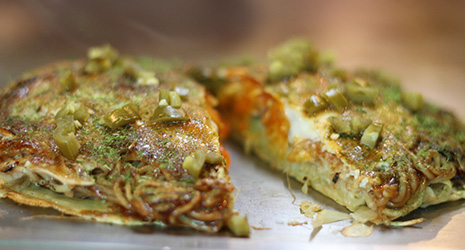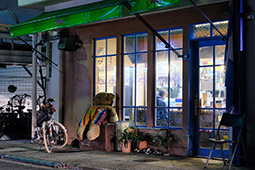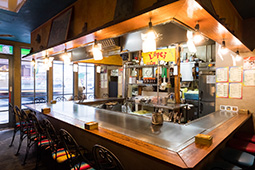Home > Highlighting JAPAN > Highlighting Japan December 2019 > My Way
Highlighting JAPAN


Connecting People through Okonomiyaki
Fernando Lopez from Guatemala runs an okonomiyaki restaurant in Hiroshima that is a hot favorite of local and international customers alike.
Okonomiyaki is a popular, inexpensive pancake dish made using a flour batter and ingredients such as meat, seafood and vegetables. The batter and other ingredients are shaped into a circle on a hot griddle, cooked, and finished with a variety of toppings including a special sauce. The sauce, a blend of vegetables, fruits and spices, has a distinctive sweet taste, and is indispensable to okonomiyaki.
There are two prefectures in Japan that are known for their okonomiyaki: Osaka and Hiroshima. Osaka-style okonomiyaki is prepared by mixing the batter and most other ingredients together before grilling them. Hiroshima-style okonomiyaki on the other hand is prepared by first making a thin crepe and then stacking other ingredients such as cabbage, noodles, pork and egg on top. The latter style is comparatively light.
The number of okonomiyaki restaurants in Hiroshima offering a wider variety of toppings than is conventional, such as cheese or kimchi, has been increasing in recent years. Okonomiyaki Lopez is one such restaurant. The restaurant’s owner-chef, Fernando Lopez, who was born in Guatemala, introduced okonomiyaki topped with jalapeño, a chili pepper native to Central and South America, for the first time.
“One of our regular customers who worked at the company next door once requested a spicy okonomiyaki topping. I served jalapeño and he really liked it. The jalapeño topping was subsequently added to our menu. I initially thought that jalapeño would not pair well with okonomiyaki. Nevertheless, other customers also liked it, and it is now a part of our regular menu,” Lopez says. The okonomiyaki he prepares is appreciated by the locals, who are particular about their okonomiyaki, and his seventeen-seat restaurant is filled to capacity almost every day.
Lopez grew up in Guatemala, which was politically unstable at the time due to a civil war. As soon as he graduated from school, he went to the United States to live with a relative. He worked as an apprentice in a restaurant, since he had always enjoyed cooking, and his skills and diligence were soon recognized, winning him quick promotions. While working at a hotel in Hawaii, he met a Japanese woman from Hiroshima whom he later married.
“I thought that Japan would be a better place for me to raise a child in the future and moved to Hiroshima in 1995. Going back to Guatemala was not an option,” Lopez says.
“Another reason to go to Japan was to open a restaurant. I could not realize this for four years, but just as I was beginning to give up, my wife’s aunt recommended that I open an okonomiyaki restaurant.”
Following her advice, Lopez worked as an apprentice in a famous okonomiyaki restaurant in Hiroshima. The owner recognized his talent, and not only passed down vital techniques but also willingly supported the opening of the new restaurant that Lopez had dreamed of. He even helped design the griddle, which is central to the preparation of good okonomiyaki, to be 3 cm thick.
The griddle requires 45 minutes to preheat and a further 15 minutes to stabilize the temperature, which means that an hour a day is spent just to get the griddle to the right temperature. The thick, large griddle may take longer to preheat than others, but it distributes heat evenly, allowing Lopez to cook okonomiyaki on any part of it, without having to worry about hot or cold spots. It takes Lopez 15 minutes to cook an okonomiyaki on the griddle, which wraps around the counter area. The slow, gentle cooking process is the key to the taste of Lopez’s okonomiyaki. When it is ready, customers enjoy eating the okonomiyaki straight from the griddle.
“There is no divider on the griddle to separate customers. People who do not know each other sometimes start talking, which is a great thing about okonomiyaki,” Lopez says.
Hiroshima, which has two World Heritage Sites—Itsukushima Shinto Shrine and the Hiroshima Peace Memorial (Genbaku Dome)—is frequented by a large number of overseas tourists, and many of them have visited Lopez’s restaurant after learning of it by word of mouth.
“Many customers have expressed a desire to live in Japan, because it offers peace and safety rivaled by few countries in the world. My time living in Japan has made me realize that many people have worked hard to achieve and maintain this peace,” Lopez says.
Each night after closing, Lopez polishes his griddle until midnight so that the next day he can connect people once again at the okonomiyaki restaurant where people are always smiling.
© 2009 Cabinet Office, Government of Japan








